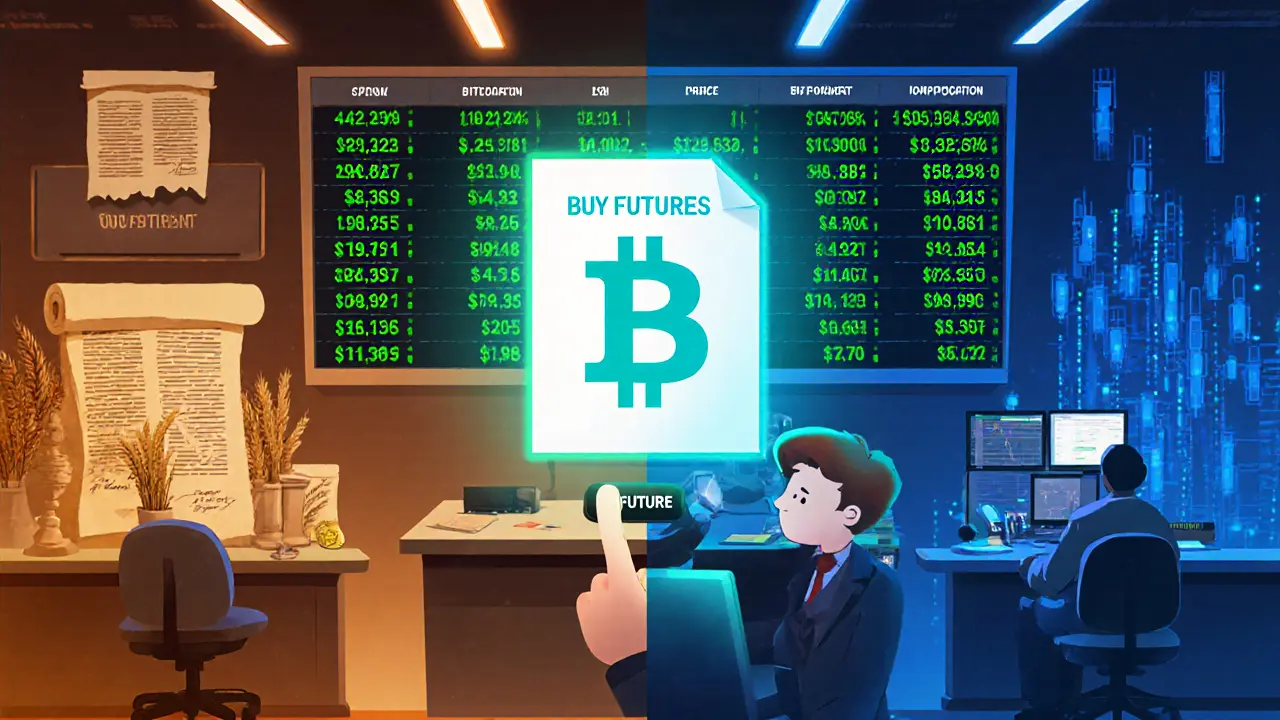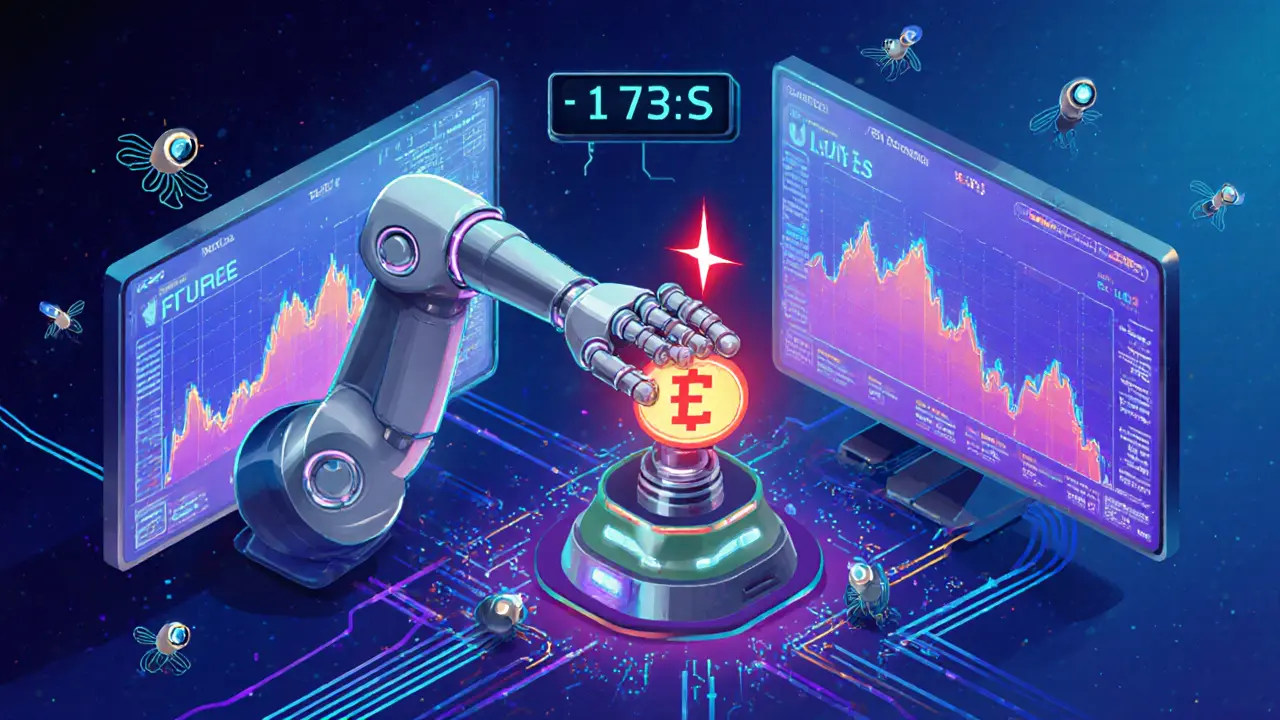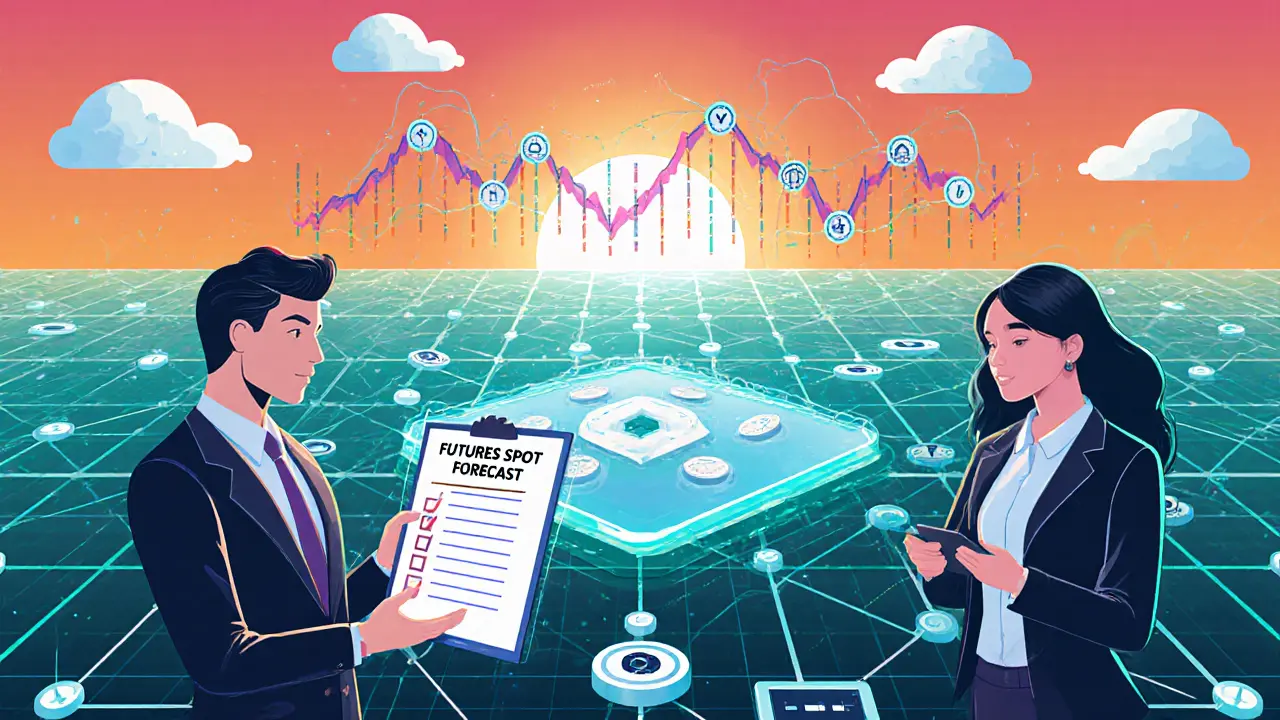How Futures Markets Shape Spot Prices: Insight for Crypto Traders

Futures-Spot Price Convergence Calculator
The Futures-Spot Price Convergence Calculator helps you understand how quickly spot prices will move toward futures prices based on current market conditions and arbitrage costs. This tool directly relates to the article's discussion of how arbitrageurs act as a "thermostat" keeping the two markets in sync.
Results
Based on CME data showing average profitable arbitrage windows of 17.3 seconds, this tool simulates how quickly price discrepancies should close in a well-functioning market.
When traders talk about the Futures market is a standardized exchange where contracts for future delivery of assets are bought and sold, they’re essentially betting on where prices will head. The ripple effect on the Spot price is the current market price for immediate delivery of an asset is what most investors care about day‑to‑day. Understanding the futures market impact on spot prices can mean the difference between a profitable trade and a costly mistake, especially in the fast‑moving world of cryptocurrency.
Why Futures Exist and How They Relate to Spot Markets
Futures contracts originated on the Chicago Board of Trade in the mid‑1800s to help farmers lock in prices for their crops. Today, the CME Group is a global derivatives marketplace offering futures on commodities, indices, and digital assets that serves a similar purpose: provide a venue for risk‑transfer and price discovery.
The core idea is simple. If you think Bitcoin will be $35k next month, you can buy a futures contract today at today’s price, lock in that expectation, and settle later. Conversely, a producer of wheat can sell futures to guarantee a future revenue level, protecting against a potential price drop.
Both parties influence the spot market because futures aggregate expectations from a broad set of market participants-speculators, hedgers, and institutional investors. When the bulk of those expectations shift, spot traders react, adjusting their immediate buying or selling decisions.
Price Discovery: Who Leads the Conversation?
Researchers use the term Price discovery refers to the process by which markets determine the price of an asset based on supply, demand, and new information. Empirical studies consistently show that futures markets dominate this process. A 2021 NARDL analysis of metals, energy, and agricultural products found futures contributed 68.3% of the information share, leaving spot markets with just 31.7%.
Why does this happen? Futures contracts are standardized, highly liquid, and traded around the clock. This creates a transparent platform where new data-like a sudden policy change or weather event-gets priced in almost immediately. Spot markets, especially in less liquid crypto pairs, often lag behind because they rely on over‑the‑counter trades or fragmented exchanges.
In practice, the convergence mechanism forces futures and spot prices to align as a contract nears expiration. Arbitrageurs spot any price gap, buy the cheaper side, and sell the expensive side, profiting from the mismatch. Within seconds, the gap disappears, pulling the spot price toward the futures price.
Arbitrage: The Glue That Binds Futures and Spot
Arbitrage is the simultaneous purchase and sale of an asset in different markets to profit from price differences. In the futures‑spot relationship, arbitrageurs act like a thermostat-keeping the two markets in sync.
Data from CME forums in 2023 show that profitable arbitrage windows average only 17.3 seconds. To exploit them, traders need low‑latency connections and algorithmic execution. Transaction costs average 0.28% of contract value, so any arbitrage strategy must beat that threshold to be worthwhile.
When arbitrage is efficient, spot price volatility tends to decrease because price errors are quickly corrected. However, if market frictions-like high fees or regulatory limits-raise the cost of arbitrage, the spot market can wander further from the futures price, amplifying volatility.
Volatility Effects: Stabilizer or Instigator?
Volatility measures the degree of price fluctuation over time, often expressed as standard deviation or variance. The relationship between futures and volatility is nuanced. Studies by Goetz et al. (2021) show that when the primary shock comes from production (e.g., a bad harvest), futures can increase spot volatility by up to 27.4%. In contrast, consumption‑driven shocks see futures dampening spot volatility by roughly 22.8%.
In crypto, the pattern mirrors traditional markets. During a sudden regulatory announcement, futures contracts often absorb the shock first, allowing spot traders a brief period of stability. But in extreme bullish runs-think the 2021 Bitcoin rally-futures may over‑react, feeding speculative pressure back into spot markets and inflating price swings.
Statistical models like GARCH model provide a framework to estimate volatility clustering and forecast future variance based on past errors have been applied to both futures and spot series. A Thai SEC study (2018) using GARCH found that after futures introduction, volatility persistence fell by 19.3% for the SET50 index, indicating a stabilizing role.

Crypto Futures: The New Frontier
Blockchain platforms have added a layer of complexity. Crypto futures-whether linear (e.g., Bitcoin perpetual swaps) or inverse (e.g., Bitcoin futures settled in BTC)-allow traders to leverage positions without owning the underlying asset. Because crypto markets operate 24/7, the futures‑spot feedback loop is continuous.
Data from the Binance Futures platform in 2024 reveal that price discovery attribution for Bitcoin reached 61% in the futures market, compared to 39% in spot. This is higher than most commodity markets, reflecting the deep liquidity and speculative nature of crypto futures.
Moreover, algorithmic traders dominate crypto futures. A BIS forecast predicts that by 2027, algorithmic trading will account for 87.4% of futures volume, accelerating information flow but also raising flash‑crash risk. When a flash crash hits futures, spot prices can tumble within milliseconds, as seen during the May 2024 “Black Thursday” event where Bitcoin futures plunged 15% in 30 seconds and spot followed 8% shortly after.
Practical Checklist for Traders
| Factor | What to Look For | Typical Impact |
|---|---|---|
| Liquidity Gap | Difference in daily volume between futures and spot | Wider gaps raise arbitrage cost → higher spot volatility |
| Contract Expiry | Days until settlement | Price convergence intensifies as expiry approaches |
| Regulatory Limits | Position limits, margin requirements | Stricter limits can delay arbitrage, widening gaps |
| Market Shock Source | Production, consumption, or inventory shock | Production shocks → possible volatility rise; consumption shocks → damping effect |
| Algorithmic Activity | Share of volume driven by bots | Higher share speeds information flow but adds flash‑crash risk |
Use this table as a quick reference before entering a futures‑based spot forecast. Combine the factors with your own risk tolerance to decide whether to lean on futures data or trust the spot order book.
Step‑by‑Step Guide to Leveraging Futures for Spot Forecasting
- Identify the most liquid futures contract for the asset (e.g., BTC perpetual swap on Binance).
- Check the open interest and volume to ensure sufficient liquidity.
- Run a basic GARCH model analysis on both futures and spot price series for the past 90 days.
- Calculate the Information Share (IS) metric; if futures IS > 60%, prioritize futures signals.
- Monitor the basis (spot‑futures spread). A narrowing basis often precedes a spot price move in the direction of the futures trend.
- Set alerts for divergence beyond your tolerance (e.g., >2% basis change within an hour).
- Implement a hedged position: go long spot, short futures (or vice‑versa) to lock in the basis if you expect convergence.
- Review post‑trade: compare actual spot movement to your forecast and adjust the model parameters.
Following these steps reduces reliance on gut feeling and grounds your view in data‑driven signals.

Emerging Trends and Future Outlook
The research frontier is now blending machine learning with order‑book dynamics. A 2023 University of Chicago paper showed that incorporating futures order‑book depth into a neural network boosted spot forecast accuracy by 31.7% over traditional GARCH models. Expect more platforms to offer real‑time APIs that feed futures depth into retail dashboards.
Regulators are also sharpening their focus. IOSCO’s 2024 guidance urges exchanges to publish 14 real‑time metrics, including the Price Discovery Measure (PDM) and Information Share (IS). Exchanges that adopt these standards give traders clearer signals about which market-futures or spot-is leading the price discovery process.
Finally, the upcoming wave of decentralized futures (e.g., perpetual contracts on Solana) could democratize access but also introduce new arbitrage challenges, as settlement is on‑chain and may experience latency. Keeping an eye on the evolution of on‑chain oracle quality will be crucial for future‑focused traders.
Key Takeaways
- Futures markets usually lead price discovery, contributing 60‑70% of the information flow for most assets.
- Arbitrage keeps futures and spot prices aligned; the faster the arbitrage, the lower the spot volatility.
- Volatility impact depends on shock type-production shocks can amplify, consumption shocks tend to dampen.
- Crypto futures are especially influential, with algorithmic trading set to dominate by 2027.
- Use liquidity, expiry, regulatory limits, shock source, and algorithmic activity as a checklist before trusting futures signals.
Frequently Asked Questions
Do futures always predict spot price movements?
Not always. In normal market conditions futures lead about 87% of the time, but during extreme bullish or bearish periods their predictive power can drop by 40% or more. Shock origin and market liquidity also matter.
How quickly does arbitrage eliminate price gaps?
CME forum data suggests the average profitable gap exists for only 17.3 seconds. High‑frequency traders capture most of it, so retail traders need ultra‑low latency connections to compete.
Can I use futures to hedge my crypto holdings?
Yes. By taking an opposite position in a futures contract you lock in a price for the underlying asset. Just watch for funding rates and margin calls, especially in perpetual swaps.
What role does the Bank for International Settlements (BIS) play in futures‑spot dynamics?
The BIS tracks global derivatives volume and publishes annual reports. In 2022 it recorded $1.84 quadrillion in notional futures value, with 73.6% influencing spot markets, highlighting the systemic importance of futures for price formation.
Is a GARCH model still relevant for crypto volatility?
GARCH remains a baseline tool, but many analysts now blend it with machine‑learning features from futures order books to capture non‑linear dynamics and improve forecast accuracy.

13 Comments
Futures really do set the tone for spot movement, especially when the open interest spikes. When you see a bulk of contracts leaning bullish, spot traders start loading up, fearing they’ll miss the upside. The arbitrage window is razor‑thin, so the price gap vanishes within seconds. Bottom line: keep an eye on the futures curve if you want to anticipate spot swings.
The article nicely outlines the mechanics, but I would stress the importance of regulatory context. Different jurisdictions impose varying margin requirements, which can delay arbitrage and widen the basis. Moreover, the volatility impact differs between production‑driven and consumption‑driven shocks, as highlighted by the cited studies. Traders should therefore calibrate their models with region‑specific limits. Overall, a thorough risk‑adjusted approach is essential.
Yo, the futures‑spot dance is like a high‑octane rap battle, and most newbies think it’s just hype. Let me tell you, when the perpetual swaps on Binance surge, the spot order book trembles like a junkyard dog. If you ignore funding rates, you’re basically signing up for a trip to the red zone. The arbitrage bots are ferocious, but they still need liquidity to chew through gaps. So, never bet against the futures flow unless you love watching your balance melt.
Exactly, the data‑driven edge comes from monitoring the basis and funding differentials.
When the futures premium shrinks, it signals a potential spot rally, especially in low‑liquidity pairs.
Just watch out for flash‑crash alerts; those can flip the script in milliseconds.
From a philosophical standpoint, futures are the collective consciousness of market participants, projecting expectations onto the present. Their aggressive price discovery forces spot markets into a reflective state, often revealing hidden risk appetites. When the futures chain overreacts, spot volatility spikes, echoing a feedback loop of fear and greed. Hence, a disciplined trader must treat futures signals as a mirror, not a crystal ball.
Honestly, all this hype feels overblown.
Spot still moves on its own.
The interplay between futures and spot is a classic case of information asymmetry, especially when institutional players dominate the derivatives market.
Passive investors often miss the early signals embedded in the futures curve.
Integrating order‑book depth into a Bayesian framework can mitigate that lag.
Great summary and useful checklist for anyone trying to bridge the two markets It's practical and easy to follow it helps newbies and pros alike to keep tabs on liquidity gaps expiry and algorithmic activity with minimal fuss
Hey folks, if you’re not already tracking the futures premium, you’re missing a golden opportunity! The basis can be a early warning system for imminent spot moves. Set up a simple alert for any deviation beyond 1% and you’ll be ahead of the herd. Remember, the faster you react, the better your risk‑reward profile.
Cool article, I like the vibe 😎
Just a heads up, sometimes the models over‑fit on short‑term noise.
Keep an eye on macro news for the bigger picture.
All this futures mumbo‑jumbo is just a fancy way for the pros to keep the little guys in the dark.
The relationship between futures and spot markets is rooted in the fundamental principle of price discovery, wherein market participants collectively assimilate new information to adjust valuations. Futures contracts, by virtue of their standardized nature and high liquidity, act as a conduit for aggregating expectations about future price movements. When a significant portion of traders adopt a bullish stance on a futures contract, this sentiment inevitably permeates the spot market, prompting participants to align their immediate buying decisions with the anticipated trajectory. Conversely, a bearish tilt in the futures market can precipitate sell‑offs in the spot arena, as risk‑averse actors seek to mitigate exposure. The arbitrage mechanism serves as the equilibrium‑maintaining force, exploiting any temporary divergence between futures and spot prices. By simultaneously purchasing the undervalued instrument and selling the overvalued counterpart, arbitrageurs enforce price convergence, typically within fractions of a second. Empirical evidence, such as the CME data indicating an average arbitrage window of 17.3 seconds, underscores the efficiency of this process in liquid markets. However, when transaction costs rise or regulatory constraints impede arbitrage activity, the spot‑futures gap can widen, amplifying volatility. This dynamic is particularly pronounced in cryptocurrency markets, where decentralized exchanges and varying funding rates introduce additional friction. Moreover, the source of market shocks-whether production‑related or consumption‑driven-modulates the impact of futures on spot volatility. Production shocks tend to exacerbate price swings, while consumption shocks often dampen them. Practitioners should therefore incorporate shock taxonomy into their risk models. Integrating GARCH or stochastic volatility frameworks with futures‑derived signals can enhance forecast accuracy, especially when complemented by machine‑learning techniques that capture non‑linear patterns. Finally, the evolution of decentralized futures platforms presents both opportunities and challenges: on‑chain settlement offers transparency, yet latency and oracle reliability remain critical considerations for maintaining price parity. In sum, a nuanced appreciation of futures‑spot interplay, informed by liquidity metrics, expiry horizons, regulatory landscapes, and shock typology, equips traders with a robust toolkit for navigating market dynamics.
Wow, that was a marathon of insight! 😮
It really drives home how every little factor can tilt the balance.
Thanks for breaking it down in plain terms.